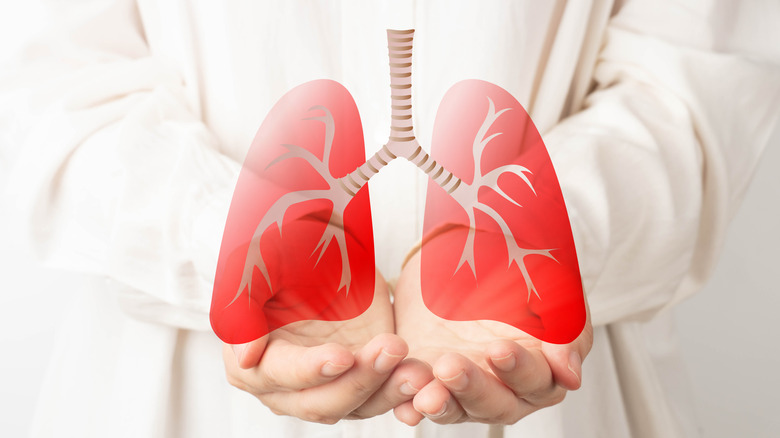What Are The Symptoms Of Walking Pneumonia?
Walking pneumonia, also known as atypical pneumonia, is a type of pneumonia that is much less severe than its traditional counterpart. Unlike traditional forms of pneumonia, which may require hospitalization, walking pneumonia is a milder form of the disease where hospitalization isn't needed, says the Cleveland Clinic. While walking pneumonia can be caused by viruses, bacteria, and mold, the most common cause is the bacteria Mycoplasma pneumonia, per the American Lung Association. The condition is typically spread through respiratory droplets, which can be expelled into the air when an infected person talks, coughs, or sneezes (via the Cleveland Clinic).
According to the American Lung Association, the term "walking pneumonia" comes from the fact that people who have it are usually able to continue their normal activities rather than needing to be on bed rest or hospitalized. This is because when compared to traditional pneumonia, symptoms more typically resemble a cold or the flu. Even though the symptoms may be mild, however, it's still important to seek medical attention if you suspect you have walking pneumonia.
Common symptoms of walking pneumonia
According to WebMD, the symptoms of walking pneumonia usually begin 15 to 25 days after exposure to the virus. As mentioned, the symptoms can be mild — similar to those of the common cold or flu — and may not always require medical treatment, per the Cleveland Clinic. A persistent cough that may produce phlegm or mucus is one common symptom of walking pneumonia. Fatigue, a mild fever, and weakness are other symptoms of walking pneumonia, along with chest pain or discomfort — particularly when breathing deeply or coughing, states WebMD.
Shortness of breath might also occur, but if it does, it won't be as severe as it can be in traditional pneumonia, according to Healthline. Sore throat and headache are also potential symptoms, as well as chills and loss of appetite. If your symptoms appear more severe, it's best to speak to your doctor. Walking pneumonia can be diagnosed based on your medical history and a physical examination.
How is walking pneumonia diagnosed and treated?
During a diagnosis, your doctor might listen to your lungs with a stethoscope to check for any breathing problems, reports Healthline. They might also perform a chest X-ray to rule out other possible illnesses. In some cases, a mucus culture may also be performed to identify the specific type of bacteria or virus causing the infection.
The treatment for walking pneumonia depends on the cause of the infection. As previously mentioned, in most cases, walking pneumonia is caused by the bacteria Mycoplasma pneumoniae and is treated with antibiotics. The most commonly used antibiotics for walking pneumonia are macrolides, such as azithromycin or clarithromycin, states the Cleveland Clinic. It's important to complete the full course of antibiotics prescribed by the doctor to ensure that the infection is completely cleared. According to the clinic, cough suppressants, NSAIDs, and other over-the-counter medications might also help reduce fever and relieve chest pain. It's also vital to drink plenty of fluids and get plenty of rest.


